|
 |
|
 |
|
|
 |
|  |
|
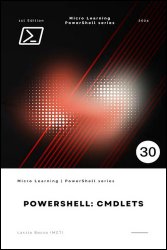 Название: PowerShell: Cmdlets Название: PowerShell: Cmdlets
Автор: Laszlo Bocso
Издательство: Independently published
Год: October 27, 2024
Страниц: 350
Язык: английский
Формат: pdf, azw3, epub, mobi
Размер: 10.1 MB
"PowerShell: Cmdlets" is the ultimate resource for mastering PowerShell cmdlets, the building blocks of this powerful scripting language and automation tool. Whether you're a beginner taking your first steps into PowerShell or an experienced IT professional looking to enhance your skills, this book provides a structured, in-depth exploration of cmdlets that will elevate your ability to manage systems, automate tasks, and handle data efficiently. This book is designed to be a complete reference and learning tool, whether you are just getting started with PowerShell or seeking to enhance your existing skills. It provides a hands-on, practical approach, focusing on real-world applications of cmdlets, along with step-by-step instructions, examples, and tips for effective usage. By the end of this book, you will have a deep understanding of cmdlets and how to leverage them to streamline and automate your tasks, increase productivity, and maintain a well-managed IT infrastructure. | |
Разместил: Ingvar16 4-05-2025, 05:32 | Комментарии: 0 | Подробнее
| | | |
 |
|  |
 |
|
 |
|
|
 |
|  |
|
 Название: Docker без секретов. Разработка и развертывание приложений с помощью Docker Название: Docker без секретов. Разработка и развертывание приложений с помощью Docker
Автор: Сайбал Гош
Издательство: БХВ-Петербург
Год: 2023
Страниц: 215
Язык: русский
Формат: pdf
Размер: 60.8 MB
Книга подробно рассказывает о развертывании и поддержке контейнерных приложений с использованием технологии Docker. Описан принцип работы образов, контейнеров и связанных с ними хранилищ Docker Storage, рассмотрена система контейнеризации Docker Swarm, показаны принципы сетевого взаимодействия Container Network Model. Раскрыты вопросы использования плагинов в сервисах Docker, рассмотрено развертывание служб в Swarm. Отдельная глава посвящена обеспечению безопасности в экосистеме Docker, масштабированию и поддержке контейнерных приложений. | |
Разместил: Ingvar16 4-05-2025, 03:40 | Комментарии: 0 | Подробнее
| | | |
 |
|  |
 |
|
 |
|
|
 |
|  |
|
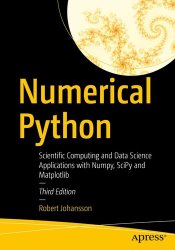 Название: Numerical Python: Scientific Computing and Data Science Applications with Numpy, SciPy and Matplotlib, 3rd Edition Название: Numerical Python: Scientific Computing and Data Science Applications with Numpy, SciPy and Matplotlib, 3rd Edition
Автор: Robert Johansson
Издательство: Apress
Год: 2024
Страниц: 501
Язык: английский
Формат: True PDF, True EPUB
Размер: 44.1 MB
Learn how to leverage the scientific computing and data analysis capabilities of Python, its standard library, and popular open-source numerical Python packages like NumPy, SymPy, SciPy, Matplotlib, and more. This book demonstrates how to work with mathematical modeling and solve problems with numerical, symbolic, and visualization techniques. It explores applications in science, engineering, data analytics, and more. Numerical Python, Third Edition, presents many case study examples of applications in fundamental scientific computing disciplines, as well as in Data Science and statistics. This fully revised edition, updated for each library's latest version, demonstrates Python's power for rapid development and exploratory computing due to its simple and high-level syntax and many powerful libraries and tools for computation and data analysis. After reading this book, readers will be familiar with many computing techniques, including array-based and symbolic computing, visualization and numerical file I/O, equation solving, optimization, interpolation and integration, and domain-specific computational problems, such as differential equation solving, data analysis, statistical modeling, and Machine Learning. For developers who want to understand how to use Python and its ecosystem of libraries for scientific computing and data analysis. | |
Разместил: Ingvar16 4-05-2025, 02:37 | Комментарии: 0 | Подробнее
| | | |
 |
|  |
 |
|
 |
|
|
 |
|  |
|
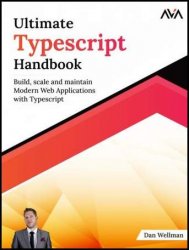 Название: Ultimate Typescript Handbook: Build, scale and maintain Modern Web Applications with Typescript Название: Ultimate Typescript Handbook: Build, scale and maintain Modern Web Applications with Typescript
Автор: Dan Wellman
Издательство: Orange Education Pvt Ltd, AVA
Год: 2023
Страниц: 438
Язык: английский
Формат: True/Retail PDF, True EPUB
Размер: 33.7 MB, 10.2 MB
Unleash the Power of Modern Web Development with Typescript. This book provides a comprehensive guide to TypeScript, a programming language that extends jаvascript with powerful features like static typing, classes, and interfaces. The book is divided into thirteen chapters that cover everything from setting up a development environment to building an Angular app with TypeScript. We start with an introduction to TypeScript and its benefits and go on to explain how TypeScript can help developers write more maintainable, scalable code and catch errors before they make it to production. The book then dives into more technical topics like basic type annotations, using the TypeScript compiler, advanced features like enums and interfaces, and manipulating types. This book is targeted towards front-end developers who are familiar with jаvascript and are interested in expanding their skillset with TypeScript. Whether you are a beginner with little to no experience or an intermediate developer looking for a reference guide, this book is designed to help you supercharge your development and enhance your tooling. With its clear and concise explanations, it's perfect for those who are new to TypeScript and looking to gain a deeper understanding of its capabilities. | |
Разместил: Ingvar16 3-05-2025, 19:29 | Комментарии: 0 | Подробнее
| | | |
 |
|  |
 |
|
 |
|
|
 |
|  |
|
 Название: 250 PowerShell Scripts for IT Professionals Название: 250 PowerShell Scripts for IT Professionals
Автор: Laszlo Bocso
Издательство: Independently published
Год: December 2, 2024
Страниц: 734
Язык: английский
Формат: pdf, azw3, epub, mobi
Размер: 10.1 MB
Unlock the full potential of PowerShell with "250 PowerShell Scripts for IT Professionals" – your comprehensive guide to mastering automation and efficiency in IT management. This practical handbook is designed for both seasoned professionals and beginners, offering a treasure trove of ready-to-use scripts that address real-world IT challenges. PowerShell has become an indispensable tool for IT professionals, system administrators, and developers worldwide. Its ability to streamline workflows, automate repetitive tasks, and manage complex IT infrastructures makes it a cornerstone of modern IT management. Unlike traditional PowerShell books that focus solely on syntax and theory, this book dives straight into practical, ready-to-use scripts. Each chapter is organized around a specific area of IT management, such as system administration, file and folder management, user account management, Active Directory, and more. The scripts are designed to be immediately applicable, helping you save time, reduce errors, and improve efficiency in your daily tasks. | |
Разместил: Ingvar16 3-05-2025, 18:38 | Комментарии: 0 | Подробнее
| | | |
 |
|  |
 |
|
 |
|
|
 |
|  |
|
 Название: Expert Linux Development: Mastering System Calls, Filesystems, and Inter-Process Communication Название: Expert Linux Development: Mastering System Calls, Filesystems, and Inter-Process Communication
Автор: Adam Jones
Издательство: NOB TREX L.L.C.
Год: 2025
Страниц: 351
Язык: английский
Формат: pdf, epub (true)
Размер: 13.0 MB
"Expert Linux Development: Mastering System Calls, Filesystems, and Inter-Process Communication" is an indispensable resource for software developers, system administrators, and advanced users eager to elevate their understanding of Linux's powerful capabilities. This meticulously curated text delves deep into the Linux kernel, elucidating the nuances of system calls, filesystem management, and the intricacies of inter-process communication. Each chapter, composed with clarity and precision, addresses critical topics such as process handling, memory management, and network programming, providing readers with a comprehensive toolkit for optimizing and securing Linux environments. Whether it's handling complex synchronization issues, debugging sophisticated applications, or securing network communications, this book offers expert guidance and practical examples to navigate and master the complexities of Linux programming. It's designed not just to inform, but to transform competent Linux programmers into adept architects of robust, efficient, and secure software systems. Embrace this resource to harness the full potential of Linux and take your programming prowess to remarkable new heights. | |
Разместил: Ingvar16 3-05-2025, 17:49 | Комментарии: 0 | Подробнее
| | | |
 |
|  |
 |
|
 |
|
|
 |
|  |
|
 Название: Быстрое программирование на С++ Название: Быстрое программирование на С++
Автор: Тяпичев Г.А.
Издательство: СОЛОН-Пресс
Год: 2017
Cтраниц: 373
Формат: pdf
Размер: 43 мб
Язык: русский
Книга предназначена для широкого круга читателей, которые не знакомы с каким-либо языком программирования, но мечтают о создании компьютерных программ собственными силами. Автор предлагает читателю самостоятельно научиться программированию в среде C++ Builder по разработанной им методике «начать от нуля». В процессе работы над книгой читатель научится создавать проекты компьютерных программ и, одновременно, будет осваивать основы языка программирования C/C++, а также требования среды программирования. В книге рассмотрены вопросы создания справочных систем и инсталляции программ, описаны особенности программирования звука и принтера, вопросы программирования для Интернета. | |
Разместил: rivasss 3-05-2025, 16:06 | Комментарии: 0 | Подробнее
| | | |
 |
|  |
 |
|
 |
|
|
 |
|  |
|
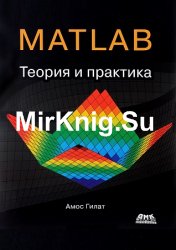
Название: MATLAB. Теория и практика
Автор: Амос Гилат
Издательство: ДМК Пресс
Год: 2016
Страниц: 416
ISBN: 978-5-97060-183-9
Формат: PDF
Размер: 10 Мб
Язык: русский
Данная книга предлагает практическое введение в MATLAB - пакет прикладных программ для решения задач технических вычислений и одноименный язык программирования. Издание охватывает все, что необходимо для эффективного использования MATLAB, от простых арифметических действий со скалярами до создания и использования массивов, трехмерных графиков и решения дифференциальных уравнений. | |
Разместил: rivasss 3-05-2025, 16:03 | Комментарии: 0 | Подробнее
| | | |
 |
|  |
 |
|
 |
|
|
 |
|  |
|
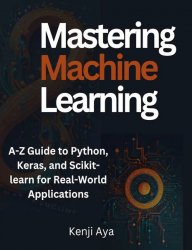 Название: Mastering Machine Learning: A-Z Guide to Python, Keras, and Scikit-learn for Real-World Applications Название: Mastering Machine Learning: A-Z Guide to Python, Keras, and Scikit-learn for Real-World Applications
Автор: Kenji Aya
Издательство: Independently published
Год: October 13, 2024
Страниц: 369
Язык: английский
Формат: pdf, epub, mobi
Размер: 10.1 MB
Machine learning is driving innovation in every industry, from healthcare to finance and entertainment. Python, Keras, and Scikit-learn are essential tools in the AI ecosystem, offering scalable solutions to build, train, and deploy intelligent models for real-world applications. This book covers everything you need to master these technologies and create your own AI solutions. Kenji Aya, an expert in Machine Learning and AI, brings his practical experience and deep industry knowledge to this book. With years of hands-on expertise in applying Python, Keras, and Scikit-learn to solve real-world problems, this book is a trusted resource for anyone looking to enhance their ML skills. "Mastering Machine Learning: A-Z Guide to Python, Keras, and Scikit-learn for Real-World Applications" is a comprehensive guide designed to help you master Machine Learning, from basic principles to advanced topics. Packed with practical examples, hands-on projects, and step-by-step tutorials, this book provides the tools you need to build and deploy Machine Learning models in real-world scenarios, whether you’re predicting customer behavior, recommending products, or analyzing images. | |
Разместил: Ingvar16 3-05-2025, 15:55 | Комментарии: 0 | Подробнее
| | | |
 |
|  |
 |
|
 |
|
|
 |
|  |
|
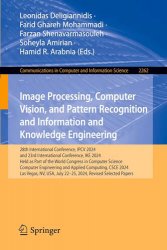 Название: Image Processing, Computer Vision, and Pattern Recognition and Information and Knowledge Engineering Название: Image Processing, Computer Vision, and Pattern Recognition and Information and Knowledge Engineering
Автор: Leonidas Deligiannidis, Farid Ghareh Mohammadi, Farzan Shenavarmasouleh, Soheyla Amirian
Издательство: Springer
Серия: Communications in Computer and Information Science
Год: 2025
Страниц: 397
Язык: английский
Формат: pdf (true)
Размер: 48.3 MB
This book constitutes the proceedings of the 28th International Conference on Image Processing, Computer Vision, and Pattern Recognition, IPCV 2024, and the 23rd International Conference on Information and Knowledge Engineering, IKE 2024, held as part of the 2024 World Congress in Computer Science, Computer Engineering and Applied Computing, in Las Vegas, USA, during July 22 to July 25, 2024. The 19 IPCV 2024 papers included in these proceedings were carefully reviewed and selected from 98 submissions. IKE 2024 received 40 submissions and accepted 10 papers for inclusion in the proceedings. The papers have been organized in topical sections as follows: Image processing, computer vision and pattern recognition; image processing, computer vision and pattern recognition - detection methods; and information and knowledge engineering. | |
Разместил: Ingvar16 3-05-2025, 14:50 | Комментарии: 0 | Подробнее
| | | |
 |
|  |
|